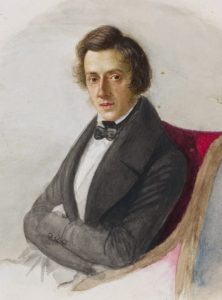
April 3, 2018
Poetry in Motion: Chopin’s Piano Concerto No. 2
Though he published it second, Chopin’s Piano Concerto in F minor was actually the first concerto he composed. After a surprisingly successful impromptu solo debut in Vienna, the nineteen-year-old composer returned home to Warsaw to compose a concerto that he could play on tours in the future. Chopin completed it during the fall of 1829 and gave the premiere in Warsaw the following March, where it was enthusiastically received.
The first movement begins with a substantial orchestral passage that introduces its main themes:
https://www.youtube.com/watch?v=jTCol3eIF24
The first is a Romantic melody of stark dynamic contrasts in F minor; the second, a more lyrical one introduced by the woodwinds in A flat major. When the piano enters, it reinterprets the first and second themes with ornamentation inspired by the expressive embellishments of bel canto opera singers. Even though the piano is technically a percussion instrument, Chopin was a master of creating smooth, singing, legato melodies for it. These lyrical themes are bridged by exquisitely crafted virtuoso passages that show Chopin’s sensitivity to the sonority of the piano. After a brief but intense passage for orchestra, the pianist returns to develop the ideas introduced earlier. Beginning tranquilly, the music become inexorably more tumultuous, building to a fiery passage for orchestra. The soloist then returns with the first theme, which quickly transforms into the second. The movement concludes with virtuoso passagework and a decisive orchestral coda in F minor.

In a letter to a friend, Chopin confessed that the slow second movement of the concerto was inspired by Konstancja Gladkowska, a young singer who was a classmate of his at the conservatory in Warsaw: “Perhaps to my misfortune, I have met my ideal and have served her faithfully for six months, without speaking to her about my feelings. I dream about it: under her inspiration, the adagio of my Concerto in F minor and, this morning, the little waltz that I’m sending you [the Waltz in B minor, Op. 69 No. 2], have been born….I tell to the piano what I confide to you.”
Unfortunately for the shy composer, this music is all that came of his unspoken infatuation. Many critics continue to regard this movement as one of his loveliest creations, comparing it to the nocturnes he would compose later. After a brief orchestral introduction, the piano plays a long, singing, poetic melody. This leads to a contrasting central section, which begins dramatically with tremolo strings. Above them the pianist imitates operatic recitative, as if speaking instead of playing music. The lyrical melody then reappears, and the movement ends as it began with the orchestral introduction.
The finale begins with a melody in the style of a mazurka, a type of Polish dance. Virtuoso passagework then leads to a contrasting, rustic theme in A flat major accompanied by strings playing col legno, with the wood of the bow. After the opening mazurka theme returns, a horn solo introduces a brilliant, F major coda.
—Calvin Dotsey
Don’t miss Chopin’s Piano Concerto No. 2 on April 26, 28 & 29, 2018! Get tickets and more information at houstonsymphony.org.






